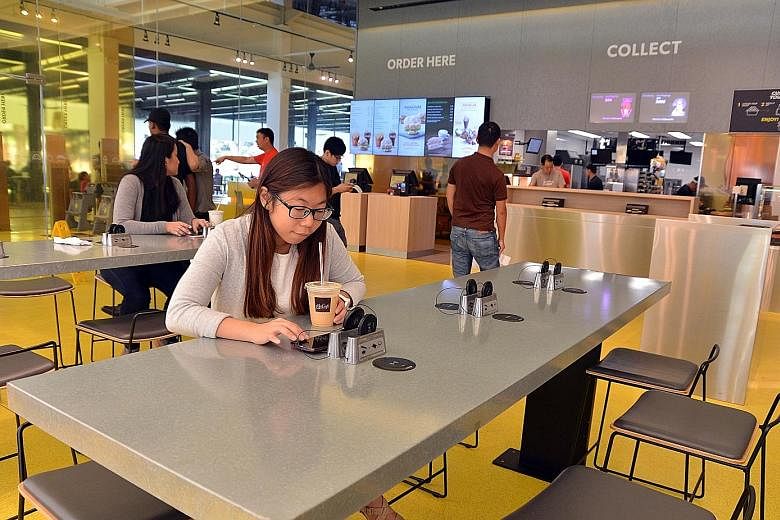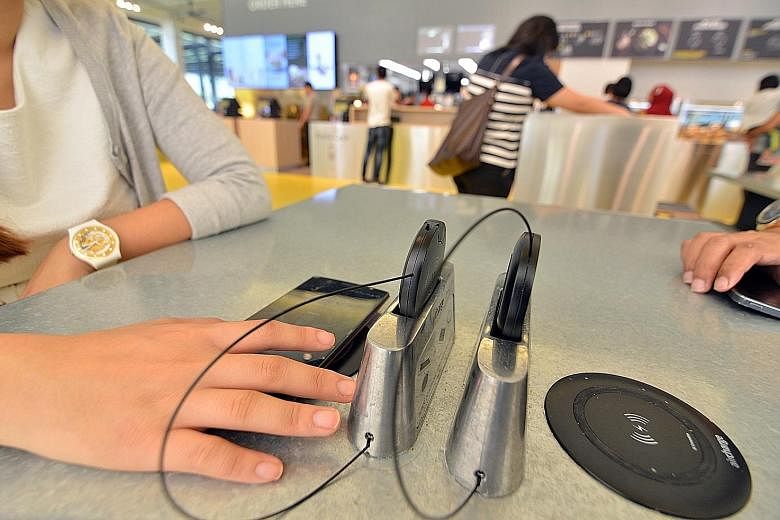If you plan on spending the day at East Coast Park, you can leave your power bank at home. This is because if your handset needs a recharge, you can head to the Marine Cove McDonald's outlet, which reopened last month with 30 wireless-charging stations.
Patrons can tap these charging stations, which use the Qi wireless standard, for free.
Those with phones that do not support wireless charging can enable the feature with the adapters found at each station.
With wireless charging, you can simply plonk your device down on the charger without having to plug in a power cable.
The Marine Cove restaurant is the only McDonald's outlet here to have wireless-charging stations. The company said it will monitor the response before deciding if it would do the same at other outlets.
The fast-food chain rolled out wireless charging stations in the United Kingdom and Germany at some outlets last year.
And more wireless-charging services are sprouting up here. United Kingdom-based wireless-charging start-up Chargifi is getting set to launch in Singapore after completing a 12-month trial with The Coffee Bean & Tea Leaf coffee chain here last month.
"In the past 18 months, we have conducted over 500 meetings with Singapore's coffee chains, hotels, bars and airlines," said Chargifi Asia CEO Charlie Barlow.
Mr Barlow added that Chargifi will launch public wireless-charging stations in Singapore this year but declined to reveal potential partners and venues,
The start-up raised US$2.7 million (S$3.6 million) in funding last year from investors such as Intel's venture arm. It aims to monetise the technology by providing a software service to help venues manage wireless-charging points and perform data analytics.
Mr Barlow also mentioned marketing opportunities for businesses such as pushing in-store promotions via notifications from the Chargifi mobile app, while the customer's phone is being charged.
Public wireless-charging stations, however, are still a rare sight, both here and around the world.
-
What it's all about and how it works
-
Wireless-charging technology is not new. The Palm Pre smartphone had it back in 2009. The technology uses electromagnetic waves to transmit energy by inducing a current within a coil inside the device, which charges the battery.
The wireless chargers in the market generally require close proximity to the device, though companies are developing wireless charging solutions that work from a distance.
Having wireless charging in a mobile device helps to reduce wear and tear of the device's charging port.
It could also help prevent inadvertent damage to the port. Most phones use the micro-USB port that needs to be plugged in the right orientation and may be damaged by improper use.
However, newer smartphones are switching to the USB Type-C variant that, like Apple's Lightning connector, has a reversible plug. This makes it almost impossible for users to plug the connector wrongly and damage the port.
Wireless-charging transmitters can also be integrated into desks, lamps and even desktop monitors to create a seamless, cable-free look in homes, offices and public venues.
Swedish furniture retailer Ikea has been selling a range of wireless-charging home furniture in Singapore since May.
An Ikea spokesperson described local sales as encouraging, but declined to reveal exact sales figures.
Wireless charging has its drawbacks. It typically takes longer as it is not as efficient as wired charging.
A study by the Colorado State University found the Qi wireless technology to be between 60 and 70 per cent efficient in power transfer.
This inefficiency shows up in the form of heat. And as the wireless charging surface gets warm, it could also shorten the lifespan of the phone's battery over time.
Vincent Chang
In 2013, coffee-chain Starbucks added wireless-charging mats to select stores in the United States. Last year, the company expanded it to the UK. However, Starbucks told The Straits Times that it does not plan to install wireless-charging stations here yet.
Unlike the Qi-based wireless- charging stations at McDonald's, the ones at Starbucks use a competing standard by the Power Matters Alliance (PMA). The two are not compatible.
The fragmented nature of the technology, with multiple competing standards, has been holding back its mainstream adoption, said IDC analyst Bryan Ma.
Market research firm IHS Markit predicts that just 10 per cent of smartphones shipped in 2016 will have wireless-charging capability.
But things have been improving. Last year, PMA merged with the Alliance for Wireless Power group to form the AirFuel Alliance, reducing the number of players from three to two.
Standing in the way of the Airfuel Alliance is the Wireless Power Consortium, which is responsible for the Qi standard, arguably the most commonly used wireless-charging technology in mobile devices.
"The presence of two standards has definitely slowed things down in terms of adoption in the smartphone market, said IHS Markit analyst Vicky Yussuff, adding that the two standards can co-exist.
She added that multi-standard solutions are already becoming available. The latest Samsung Galaxy S7 and S7 edge smartphones support both Qi and PMA standards.
Tech giant Apple has yet to implement wireless charging in its iPhones. But the firm recently dipped its toes into the technology with the Apple Watch.
This leads Ms Yussuff to predict that Apple will release a wireless-charging-enabled iPhone in the next 18 months.
Mr Ma believes that it could take years to iron out the kinks in wireless charging in mobile devices. But he says that the technology could gain traction in wearables and motor vehicles. "Wireless charging makes sense for wearables given the small size constraints and waterproofing issues around open USB ports," he said.
The technology can also reduce cable clutter in cars. Models from the likes of Audi, General Motors and Toyota already come with wireless chargers.
But there is a long road ahead for the technology to win over the average consumer.
Samsung Galaxy S6 owner Christopher Chua got a free wireless-charging pad when he bought the phone last year. But he stopped using it after a while.
"I charge my phone when I go to bed. But the wireless charger stops working when the phone is fully charged. I wake up the next morning and the phone is less than 100 per cent charged," he said.



